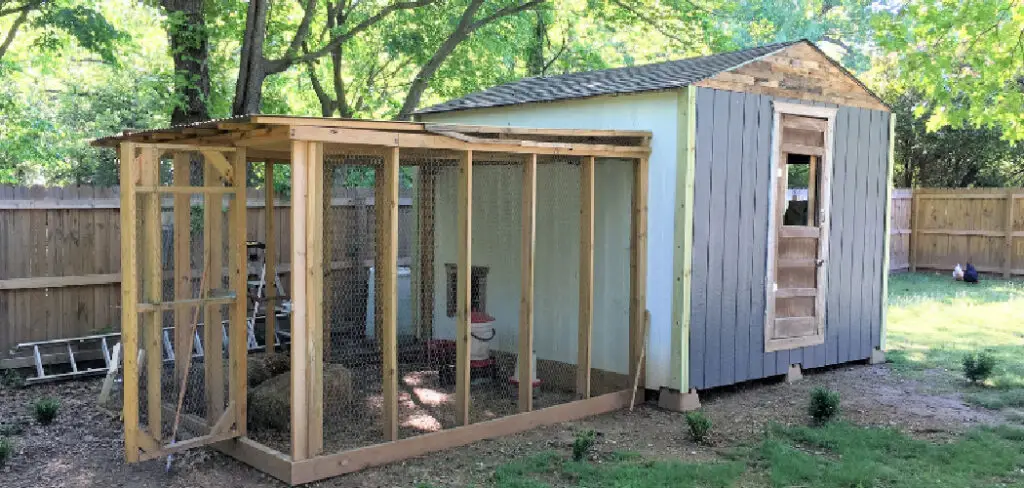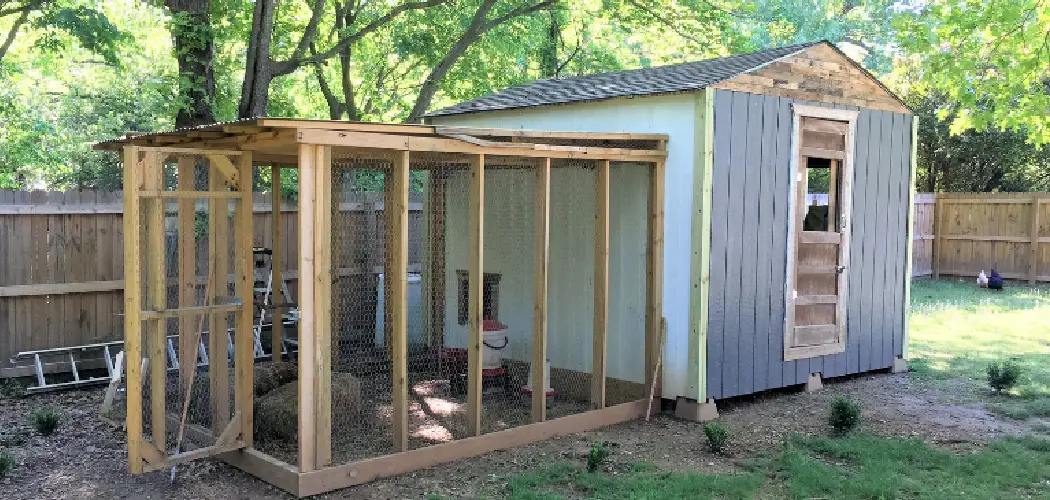Building a chicken coop doesn’t have to be an expensive or complicated project. With some creativity and basic materials, you can create a functional and cost-effective space for your chickens to live and thrive.

A well-designed coop will provide your flock with protection from predators, shelter from the elements, and a comfortable environment for laying eggs. This guide will show you how to build a chicken coop cheap without sacrificing quality or safety.
Importance of a Chicken Coop
A chicken coop is essential for maintaining the health, safety, and productivity of your flock. It provides a secure space that protects your chickens from natural predators, such as foxes, raccoons, or hawks. Additionally, a coop shelters your birds from harsh weather conditions, including rain, wind, and extreme temperatures, ensuring their well-being throughout the year.
A well-designed coop also helps prevent the spread of diseases by keeping your flock contained and away from potential contaminants. Furthermore, having a designated coop encourages consistent egg-laying by offering nesting boxes and a calm environment for hens. Overall, a chicken coop is a critical component of raising healthy, happy, and productive chickens.
Planning Your Cheap Chicken Coop
When planning a cheap chicken coop, the key is to balance affordability, functionality, and durability. Start by assessing the size of your flock to determine the space requirements; each chicken will need approximately 2-3 square feet of indoor space and 8-10 square feet of outdoor run space. Consider using cost-effective materials such as reclaimed wood, pallets, or upcycled materials that you can often obtain for free or at a low cost. Focus on creating a sturdy structure with adequate ventilation to keep the coop fresh and prevent moisture buildup, which can lead to health issues. Don’t forget to include nesting boxes, roosting bars, and safe access to the outdoors. With careful planning and a bit of creativity, you can construct a coop that meets your chickens’ needs without breaking the bank.
10 Methods How to Build a Chicken Coop Cheap
Use Recycled and Salvaged Materials for the Frame and Walls
One of the best ways to build a chicken coop on a tight budget is to use recycled materials whenever possible. Visit local construction sites, lumberyards, or online marketplaces like Craigslist or Facebook Marketplace for leftover wood, used pallets, old doors, or sheets of plywood. Many businesses discard or give away these items for free.

Pallets, in particular, make excellent coop frames or wall panels and are often available at no cost. With a little creativity, you can piece together a sturdy, functional coop frame using mostly salvaged wood, dramatically reducing your overall costs without sacrificing durability.
Convert Existing Structures Like Sheds or Playhouses
Instead of building a coop from scratch, repurposing an existing structure such as an old shed, doghouse, or children’s playhouse can save you a lot of money and labor. These structures already provide a basic enclosure and weatherproofing, giving you a solid starting point. All you need to do is modify the interior for nesting boxes and perches, and perhaps add ventilation, secure mesh windows, and a pop-door for the chickens to enter and exit. This method not only saves money on lumber and roofing but also drastically cuts down on construction time.
Build a Small Coop for a Small Flock
If your flock is small—say, 3 to 5 hens—there’s no need to build a huge structure. A compact coop can still provide the comfort, shelter, and laying space your chickens need while keeping costs low. Focus on the essentials: nesting boxes, roosts, good ventilation, and predator-proofing. A smaller coop uses fewer materials and can often be constructed in a single weekend. Plus, it’s easier to insulate, clean, and move if needed. Keeping your build to a minimalist size prevents overspending while ensuring your birds have everything they require.
Use Chicken Wire or Hardware Cloth Sparingly and Strategically
Chicken wire and hardware cloth are essential for predator protection but can be expensive when used in large quantities. To save money, use them strategically. Reserve hardware cloth (the stronger option) for the most vulnerable areas: windows, vents, and the lower part of the coop where predators might try to dig or chew through. Chicken wire, while not as durable, can be used for the run or less critical zones. Also consider using salvaged fencing materials or mesh panels from old screen doors to reduce costs even further. Always secure any mesh tightly with staples or screws and washers.
Roof with Corrugated Metal, Reclaimed Shingles, or Tarp
Roofing materials are often among the most expensive parts of any construction project. To save money, look for reclaimed roofing panels like corrugated metal sheets or old shingles. Many roofing companies have surplus or slightly damaged pieces that are still usable for a coop.

Alternatively, a heavy-duty waterproof tarp stretched over a slanted wooden frame can serve as a temporary or seasonal roof. Just ensure proper drainage and secure it tightly to avoid wind damage. Protecting your chickens from rain and snow doesn’t have to be expensive—it just needs to be effective.
Use Buckets, Crates, or Repurposed Drawers for Nesting Boxes
Instead of buying manufactured nesting boxes, which can be costly, consider repurposing items like 5-gallon buckets laid on their sides, wooden crates, milk crates, or even old dresser drawers. Line them with straw or pine shavings and mount them a few inches off the ground inside the coop. Chickens don’t need anything fancy—just a clean, quiet, and dark space to lay their eggs. Make sure to secure or weigh down lightweight boxes so they don’t tip. Using salvaged containers not only cuts down costs but also encourages creative reuse.
Build Roosts from Branches or Scrap Wood
Roosting bars provide a perch for your chickens to sleep off the ground, which is healthier and more comfortable for them. Rather than buying lumber, you can use sturdy tree branches, broom handles, or leftover 2×2 or 2×4 boards. Chickens prefer rounded or slightly flattened surfaces about 2 inches wide. Mount the roosts higher than the nesting boxes to discourage chickens from sleeping where they lay. Roosts don’t require much material, and by using found or scrap wood, you can create a cozy nighttime perch for next to nothing.
Design a Simple Sloped Floor for Easy Cleaning
Keeping your coop clean reduces odor, illness, and maintenance headaches. You don’t need expensive flooring systems—just create a slightly sloped wooden floor or a dirt floor that’s raised off the ground. Cover it with pine shavings, straw, or leaves, which are cheap and absorbent. A sloped surface encourages moisture to drain away, keeping the coop dry. If you want to go a step further, add a removable tray or slide-out board underneath the roost to collect droppings—made from old plywood or sheet metal—making clean-up even easier.
Use a Free or Low-Cost Coop Plan Designed for Budget Builds
Rather than designing from scratch or buying costly blueprints, download one of the many free chicken coop plans available online that focus on affordable materials and simple construction.

Many plans are tailored for beginners, using basic tools and low-cost building supplies like pallets or reclaimed wood. These guides offer measurements, diagrams, and tips that can help you avoid mistakes and save money on trial-and-error building. With a good plan, you’ll use your materials efficiently and avoid overbuying or building unnecessary features.
Create a Free-Range Area or Simple Fenced Run with Natural Barriers
Instead of building a large enclosed run, consider allowing your chickens to free-range in your yard during the day or building a simple fenced-in run using natural barriers. Use salvaged fencing, leftover lattice, or even bamboo poles to form a makeshift enclosure.
Supplement this with bushes, shrubs, or garden structures to provide cover. Chickens benefit from space to forage, and free-ranging reduces the size and complexity of the coop needed. If predators are a concern, guide your flock back into the coop before dusk and lock it up securely at night.
Safety Considerations
Ensuring the safety of your chickens is paramount when allowing them to free-range or when building their enclosure. Predators such as foxes, raccoons, hawks, and neighborhood dogs can pose significant threats, particularly during the evening and early morning hours. To mitigate risks, install predator-proof latches on the coop and make sure there are no gaps or weak points in enclosures where animals could squeeze through.

Consider burying fencing at least 6 inches into the ground to prevent burrowing predators from gaining access. Additionally, investing in motion-activated lights or decoys such as owl statues can help deter some predators. Regularly inspect your coop and surrounding areas for signs of attempted breaches to address vulnerabilities promptly. Prioritizing safety will ensure your chickens thrive in a secure and stress-free environment.
Conclusion
Building a chicken coop cheaply doesn’t mean cutting corners on quality or safety—it means being resourceful, reusing materials, and focusing on what your flock truly needs. With creativity and effort, you can build a durable, predator-proof coop that keeps your chickens healthy, happy, and productive—all while staying well within your budget. Whether you’re converting an old shed, salvaging pallets, or rigging up crates for nesting boxes, these ten cost-cutting methods prove that frugality and function can go hand in hand in backyard chicken keeping.

